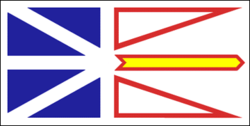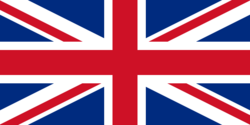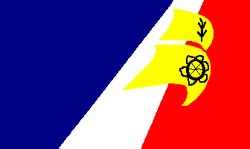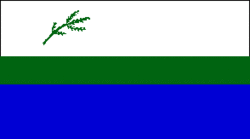Flag of Newfoundland and Labrador
|
|
| Contents |
Provincial Flag
The current flag of Newfoundland and Labrador was introduced in 1980, and was designed by Newfoundland artist Christopher Pratt. The flag design was approved by the Newfoundland provincial legislature on May 28, 1980 and was first flown on Discovery Day; June 24, 1980.
The design was chosen due to its broad symbolism. The blue colour represent the sea, the white colour represents snow and ice, the red colour represent the effort and struggle of Newfoundlanders and Labradorians, and the gold colour symbolizes the confidence Newfoundlanders and Labradorians have in themselves.
The blue triangles are meant as a tribute to the Union Flag, and stand for the British heritage of Newfoundland and Labrador. The two red triangles are meant to represent the two areas of the province--the mainland and the island. The gold arrow, according to Pratt, points towards the "brighter future".
Newfoundland Tricolour
Flag Ratio: 1:2
The flag of Newfoundland from 1840 to 1931 was the Tricolour Flag, sometimes known as the "Green, White, and Pink". It originated in St. John's in 1840 and was created by the Roman Catholic Bishop of Newfoundland, Michael Anthony Fleming. The flag is symbolic of a tradition between local Protestants and Catholics. During annual wood hauls for the Anglican cathedral and Roman Catholic cathedral, considerable rivalry developed between the two groups involved. The Protestant English marked their wood piles with the pink flag of the Natives' Society, while the Catholic Irish used green banners. The threat of violence was such that Bishop Fleming intervened, and persuaded them to adopt a common flag , on which the pink and green would be separated by a white stripe to symbolize peace. The pink symbolized the Tudor Rose of England (The Protestants) and the Green symbolized St. Patrick's Emblem of Ireland (The Catholics). The White is taken from St. Andrew's Cross (St. Andrew is the Patron Saint of Fishermen and Scotland).
The following song about the tricolour flag was frequently sung during the early 20th century, and became an alternative national anthem. It was written by Archbishop Michael F. Howley in 1902.
The Flag of Newfoundland
- The pink the rose of England shows,
- The green St. Patrick's emblem bright,
- While in between the spotless sheen
- of Andrew's cross displays the white.
- Then hail the pink, the white, the green;
- Our patriot ring long may it stand,
- Our sire lands twine their emblem trine
- To form the flag of Newfoundland.
- What e'er betide our ocean bride
- That nestles midst Atlantic foam,
- Still far and wide we'll raise with pride
- Our native flag, o'er hearth and home.
- Should e'er the hand of fate demand
- Some future change in our career,
- We ne'er will yield on flood or field
- The flag we honour and revere.
- Fling out the flag o'er creek and crag;
- Pink, white and green, so fair, so grand;
- Long may it sway o'er bight and bay,
- Around the shores of Newfoundland.
Union Flag
Flag Ratio: 1:2
The old flag of Newfoundland was the Union Flag and was adopted in 1931 and used until 1980. See current flag at the top of this article.
Franco-Terreneuviens Flag
Flag Ratio: 1:2
The flag of the F้d้ration des Francophones de Terre-Neuve et du Labrador is based on the French tricolour and Acadian flag, with three unequal panels of blue, white, and red. Two yellow sails are set on the line between the white and red panels. The sail on top is charged with a spruce twig, while the bottom sail is charged with a pitcher flower. These emblems are outlined in black. The sails represent early Basque, Breton and French fishermen that came to the area in 1504. At the same time, they are symbols of action and progress. The yellow is taken from the star of the Acadian flag. The spruce twig is the emblem of Labrador and is also found on the Labrador flag. Newfoundland and Labrador's provincial flower is the insect eating pitcher plant.
Labrador Flag
Flag Ratio: 1:2
Adopted in 1949, The top white bar of the Labrador flag represents the snows, the one element which, more than any other, coloured the culture and dictated the Labrador lifestyle. The bottom blue bar represents the waters of the rivers, lakes and oceans. The waters, have nurtured the fish and wildlife that was the basis of the early Labrador economy. The centre green bar represents the land - the green and bountiful land, which is the connecting element that unites the three diverse cultures.
The twig of the black spruce tree, in two year-growths, represents the past and the future. The shorter growth of the inner twigs represents the hard times of the past, while the longer outer twigs speak of our hopes for the future. The twig is typically in three branches and represents here the three original founding races of modern Labrador - the Innu, the Inuit and the white settler. The three branches emerging from a common stalk represents the commonality of all humankind regardless of race.





